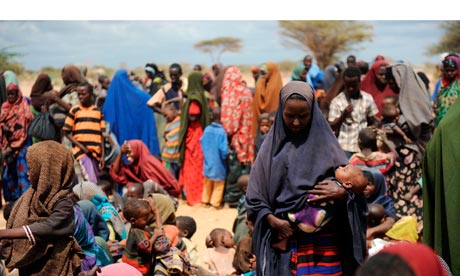Aid agencies have launched multimillion-pound appeals to address a mounting humanitarian emergency in east Africa, where severe drought and high food prices have left 10 million people requiring assistance.
Two successive failed rainy seasons in 12 months have led to the driest year since 1951 in some pastoralist regions of Kenya, Somalia, Ethiopia, Djibouti and Uganda. Hunger levels have jumped sharply, with rates of severe malnutrition rising as high as five times the emergency threshold. The drought has also decimated livestock, while cereal prices have soared.
Oxfam launched its biggest ever appeal for Africa on Monday, seeking £50m to help three million people. Christian Aid has also launched an appeal, while Save the Children will do so on Tuesday. The British government announced on Sunday that it was giving £38m in emergency food aid to Ethiopia, following a warning from Josette Sheeran ,the World Food Programme executive director, that "desperate hunger" loomed across the Horn, "threatening the lives of millions".
The latest "creeping disaster", as the WFP calls it, threatens to eclipse other recent food emergencies in the region that were caused by failed rains as well as poor planning by local governments and, in Somalia's case, conflict.
"This has all the makings of a really severe drought," said Stephen Gwynne-Vaughan, CARE's director in Kenya.
The short rains late last year were some of the worst on record according to the UN humanitarian agency, OCHA, while the long rains of April and May started late and were less than a third of the normal volume in some places.
For Somali refugees arriving in neighbouring Ethiopia, rates of severe malnutrition are as high as 23%, according to Oxfam. A 4% incidence normally constitutes an emergency.
Alun McDonald, spokesman for Oxfam in Nairobi, said the figures were the worst the agency had seen since the early 90s. At least 500 people are believed to have died in Somalia over the past few months of nutrition-related illnesses, he said.
"We are not yet at a stage where large numbers of people are dying. But things could get even worse in the coming months as the next rains are only due in October."
Up to 1,000 Somalis a day are also streaming across the Kenyan border to Dadaab, already the largest refugee settlement in the world, with 367,000 residents. "Thousands of Somalis are walking for weeks to reach the camp, many of them arriving acutely malnourished, dehydrated, with nothing but the clothes on their backs," said Gwynne-Vaughan.
Some 2.5 million people require food aid in Somalia, but access is tough, particularly in the south, where an Islamist insurgency has made it hard, and in some parts impossible, for aid groups to operate. To the west, in Ethiopia, 3.2 million people require humanitarian assistance. Pastoralist communities there have seen 80% of their livestock die in some places, according to Oxfam, with the lost income making it extremely difficult for people to buy food.
In Uganda 600,000 people need assistance, and in Djibouti 120,000. But the greatest number of people in need, 3.5 million, are in Kenya's arid northern regions, whose marginalisation by the government has magnified the effects of the increasingly frequent droughts. In Turkana malnutrition rates are more than twice the emergency level.
The price of cereals in Kenya has soared in recent years, partly due to an increase in global commodity prices. But a shortage of the staple maize has also been blamed on poor planning by the government, which claimed to have a surplus of grain when the alarm was raised earlier this year, then suddenly declared a national disaster on May 30. There have also been allegations that politically connected middlemen have sold maize meant for domestic consumption to neighbouring countries.
In Mandera, in Kenya's far north, the price of maize has increased 57% in a year, according to OCHA. In Jijiga, Ethiopia, the cost of maize has doubled, while in Baidoa, Somalia, sorghum now costs more than three times what it did in May 2010, beyond the range of the poorest families.
"High food prices, fluctuating rainfall, a rising population and ever dwindling natural resources have created the perfect storm," said Leigh Daynes, director of communications for Plan, in the UK.
More than half the 10 million people requiring assistance are children.










